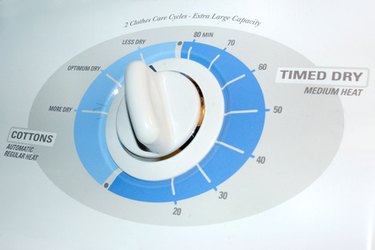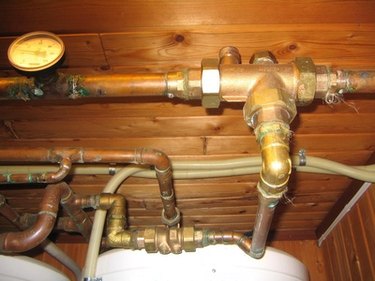
The most common cause of mold on interior walls is moisture, according to Blackmold.Awardspace. Other elements are involved in its growth; mold needs a food source, such as wood or drywall; darkness; warmth; oxygen; and time (24 to 48 hours). Moisture, though, is what begins the process. There are several ways moisture can accumulate, setting the stage for mold growth.
Humidity
Video of the Day

Because humidity is in the air, mold can grow anywhere that air touches, including the corners of your rooms. Humidity comes from a variety of sources: After a lot of rain, the air outside and inside your home may remain humid. Drying your clothes inside or in a dryer that is not vented outside places moisture in the air, and some heating and cooling systems add moisture inside your home. When moisture in your house evaporates, it increases humidity that can linger and, in turn, create puddles or other accumulations of water that take longer to dry.
Video of the Day
Leaks

Water leaking from pipes often go undetected because pipes are hidden from view. Usually when you discover the leak, mold has started to grow already under floors and in ceilings or behind your walls. On lower levels of your home, this will cause mold to grow in the upper corners of your rooms as water pools behind them. Leaky roofs are also problematic and usually aren't detected until it's too late. A leaky roof can cause mold to grow in upstairs rooms by pooling in attics or ceilings, creating a perfect environment for mold growth.
Condensation
Whether or not you have humidity, according to Blackmold.Awardspace, the air in your home still contains water vapors. This moisture remains until there is a temperature change. When warm air meets cold surfaces, like poorly insulated exterior walls, moisture in the warmer air is released, making the walls damp. Rooms with exterior walls are most likely to have mold growth in the corners because of the warm air inside meeting the cooler air outside or vice versa, depending on the season.
Poor Ventilation
Poor ventilation leads to little or no fresh air coming in or stale air going out. This makes pockets of moist air in which mold thrives. Moist air from steam and water must be circulated to keep the moisture levels in your home balanced. In a properly ventilated home, it does this through windows or fans. In a home that isn't properly ventilated, surfaces stay wet longer, which, according to dsp Inspections, creates a perfect opportunity for mold to grow in corners and on walls in kitchens and bathrooms in particular.